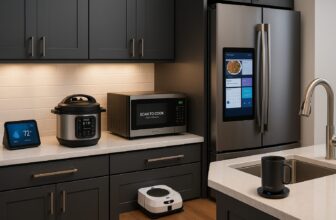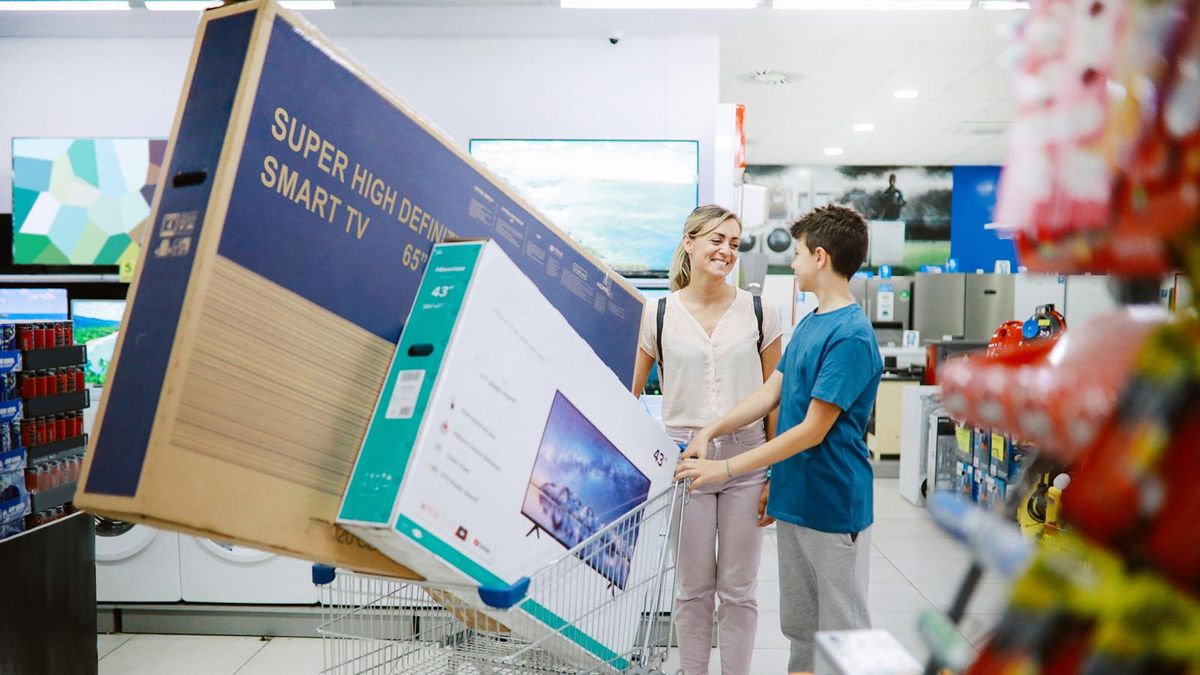
If commercial TVs don’t blow you away, maybe the large screen sizes in stadiums will.
1. Turner Field
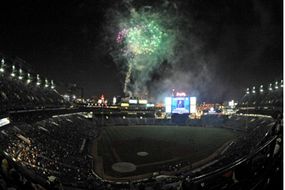
Al Messerschmidt/Getty Images
Turner Field is home to the Atlanta Braves baseball team. It’s also home to a really big HDTV screen. In 2005, stadium owners spent $10 million for an HDTV the likes of which the world had never seen before.
With nearly 1,300 inches of diagonal display area (5,600 square feet, or 520.3 square meters), this Mitsubishi Diamond Vision screen is really, really big. At the time of its installation, it was the largest in the world, as verified by the Guinness Book of World Records.
It weighs roughly 50 tons and contains more than 5 million LEDs to create bright, clear pictures encompassing one billion colors. It measures 79 feet (24.1 meters) wide by 71 feet (21.6 meters) tall [source: Bell].
The 400,000-watt screen requires 10 cooling fans that move about 60,000 cubic feet (1,699 cubic meters) of air every minute. And it’s so big that the back side of the screen has a nine-tiered catwalk for service access.
2. Yankee Stadium
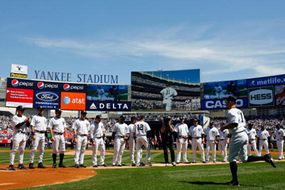

“


Jim McIsaac/Getty Images
In a rare act of frugality, the owners of Yankee Stadium didn’t go for the biggest and baddest HDTV screen when they opened their new park in April 2009. Instead, they opted for a screen that (at the time) was the third-largest screen in the world.
Similar to the Braves, the Yankees also opted for a Mitsubishi Diamond Vision screen. This one, however, measures 101 x 59 feet, or 5,925 square feet (550.5 square meters) of display area. If you were to measure this screen diagonally like your desktop’s monitor, you’d be looking at 117 feet (or 35.7 meters) of high-definition action [source: Fermoso].
What’s more, it can project up to four simultaneous HD images. Believe it or not, this screen is still just a pint-sized version by contemporary standards.
3. Chase Field
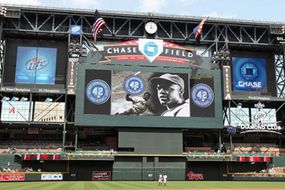

“


Christian Petersen/Getty Images
The Arizona Diamondbacks baseball team plays at Chase Field, home to another giant screen. This 136 x 46-foot (41.5 x 14-meter) screen has 6,256 square viewable feet (581.2 square meters) of HD pleasure [source: Business Wire].
And of course, it didn’t come cheap. Between production and installation, the Daktronics screen cost around $1 million [source: KTAR]. The screen’s landscape orientation (and the fact that it’s eight times bigger than the team’s old scoreboard) means it can display two true HD images side by side at a 16:9 aspect ratio. It also produces around 4.4 trillion colors.
The HDTV was just one of the high-tech components added to Chase Field. As part of a major renovation project, the stadium also added a brand-new sound system and LED ribbon boards to show scores and information throughout games.
4. Land Shark Stadium
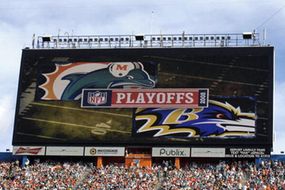

“


Al Messerschmidt/Getty Images
In 2006, Dolphin Stadium (now named Land Shark Stadium) installed a truly colossal HDTV screen overlooking the gridiron. Manufactured by Daktronics, the board measures 137 x 50 feet (41.8 x 15.2 meters), for square footage measuring approximately 6,850 (636.4 square meters) [source: Daktronics].
At the time, this screen was the biggest HDTV on the planet. It features more than 4.6 million red, green, and blue LEDs, for a resolution of 2,112 pixels wide by 736 pixels high.
The display features two Daktronics ProStar screens that use an aspect ratio that’s wider than the 16:9 wide-screen ratio of HD television broadcasts. That means fans get a super-wide, almost panoramic, view of the action on the field.
5. Darrell K Royal-Texas Memorial Stadium
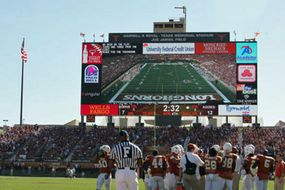

“


Ronald Martinez/Getty Images
Sometimes the cliché about things being bigger in Texas is true. The University of Texas went for worldwide recognition when it installed an HDTV at Darrell K Royal-Texas Memorial Stadium.
Nicknamed “Godzillatron,” and created by Daktronics, the screen measures 134 feet (40.8 meters) wide by 55 (16.8 meters) high, for a square footage of 7,370 (684.7 square meters) [source: Associated Press]. Diagonally, the screen measures 145 feet (44.7 meters), or roughly 1,740 inches (4,420 centimeters).
At a cost of nearly $8 million, it probably goes without saying that this display is also one of the biggest in a collegiate arena.
Part of $150 million in stadium renovations, the screen needs so much power that the university had to install new power utilities to run it. And keeping this baby cool in blistering Texas heat is no easy task; the school bought no fewer than 40 5-ton air-conditioning units to make sure it doesn’t fry in the sun [source: Associated Press].
6. Tokyo Racecourse
While Americans were having most of the outrageous HDTV fun, Japan decided it wanted a piece of the action, too. The Tokyo Racecourse, a horse-racing venue, decided to up the huge-HDTV ante.
The owners went for broke by installing a display measuring 218 feet (66.4 meters) wide by 37 feet (11.3 emters) high, or 8,066 square feet (749.4 square meters) [source: Lawler]. If you were to measure this screen diagonally (misleading due to its extreme length), you’d come up with 221.2 feet (67.7 meters).
The cost for this Mitsubishi Diamond Vision display? A measly $28 million.
The screen is so big it can show action from three different horse races simultaneously. It’s as big as three tennis courts. In fact, the screen is so big that Mitsubishi had to deliver it in 35 separate pieces.
7. Kauffman Stadium
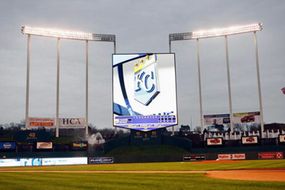

“


G. Newman Lowrance/Getty Images
Before opening day in 2008, the Kansas City Royals baseball team bought an HDTV screen that was the largest in the world upon installation. At 85 feet (26 meters) wide by 105 feet (32 meters) tall, the screen features the Royals’ signature golden crown at the top [source: Daktronics].
But the Kauffman screen isn’t a single screen. It’s actually three high-definition screens fitted together as one. And you won’t find just one person running the display during a game, either — it takes a production team of 20 people to input data, update stats and sort endless display options.
8. Cowboy Stadium
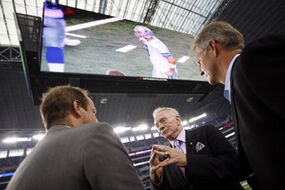

“


Tom Pennington/Getty Images
The preceding HDTVs were just a warm-up for our final entry: the HDTV in the Cowboys Stadium. The television was certified as the largest HDTV in the world on Sept. 25, 2009, by the Guinness Book of World Records [source: Leahy].
There aren’t enough adjectives in a thesaurus to describe this collection of Mitsubishi Diamond Vision displays, which can create a single image stretching nearly from one 20-yard line to the other. It took Mitsubishi more than a year to construct the screen; installation required another four months.
This HDTV really is the heavyweight champion of the world — even though it’s directly over the playing field (about 90 feet or 27.4 meters up) it tips the scales at 600 tons [source: Miles].
The screen uses 30 million LEDs and has more than 11,000 square feet (1,022 square meters) of viewable surface area. It consumes 635 kilowatts of power [source: Mitsubishi Electric Europe]. The entire shebang cost right around $40 million [source: Miles].





